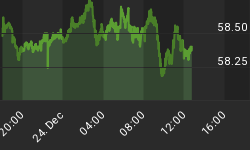The US jobless report on Friday sparked a jump in Treasury bond yields, sending the yield on 10-year Notes to 3.95% - the highest level since June last year.
The yield on 10-year Treasuries is at long last catching up with the stronger underlying economy as measured by the GDP-weighted ISM PMI. Also, the Fed's purchasing of $1.25 billion of mortgage-backed securities ended last week, resulting in artificially lower long rates coming to an end.
Additionally the US bond market is facing a crucial time this week, with $82 billion in government bond auctions that could push yields beyond their current 10-month highs. And pundits will, needless to say, also be cognizant of massive further issuance still lying ahead. (Click here for James Grant's take on Treasury yields.)
The short-term picture for the 10-year Treasury Note shows the yield having broken upwards through its 50- and 200 day moving averages and looking set to breach the top boundary of a symmetrical triangle.

Source: StockCharts.com
Monthly data, going back to 1998, also convey an important message when considering the two momentum-type oscillators (ROC and MACD) at the bottom of the chart below. The ROC reversed course (crossing the zero line) in October last year for the first time since a buy signal was given at the beginning of 2007, thereby flashing a primary sell signal. The MACD provided a similar indication in June 2009.

Source: StockCharts.com
Still on the topic of long-term data, actually all the way back to 1850, the graph below featured in a recent report by Pring Turner Capital Group asking: "Are you prepared for a secular bear market in bonds? Bond owners beware". As shown, the yield is just below its secular down trendline and it would not take a large move in yields to mark the end of the almost 30-year secular decline. What will this do to the US's debt burden, the economic recovery and stock market valuations?

Source: Pring Turner Capital Group
On the economic front, with the further reduction of inventories coming to a close the US could be in for rising inflation propelled by the US GDP-weighted PMI for prices and oil prices.

Source: Plexus Asset Management (based on data from I-Net Bridge).
Bond yields in mature markets are likely to rise further as the global GDP-weighted manufacturing PMI continues to indicate global economic expansion. Current indications are that the yield on the 10-year Note may increase another 25-50 basis points in the coming months. However, the rise in bond yields may be kept in check as uncertainties regarding the impact of the global unwinding of stimulatory measures increase.
The last words go to Richard Russell (Dow Theory Letters) who said: "As for the bond market, I think it's looking far ahead to the time when it will be difficult to sell US debt. There's going to be just too much US debt to sell. But why can't the Fed just print the money, and with that 'garbage money' mop up the US debt? That would mean the US was monetizing its debt, which would be highly inflationary.
"The new Obama health-care will most likely add billions of dollars to the total national debt. Nobody any longer is laughing at the idea of the US reneging on its debts. It sounds outlandish, but 'escapes' tend to change with the times. Now, for the first time, we hear talk of lowering the debt rating of US Treasury bonds. This would be a disaster. To sum it up, I believe the great bond bull market (1980 to 2010) has ended and that we're now entering a great bear market in bonds."
One could short US long bonds in a number of ways by means of ETFs, for example buying the ProShares Short Barclays Capital 20+ Year US Treasury Index ETF (TBF) or, for those more aggressively minded, the leveraged (2x) ProShares UltraShort 20+ Year Treasury Bond ETF (TBT). A full list of these ETFs is provided here by Stock-Encyclopedia.com. On a tactical implementation note, given the strong rise in yields over the past two weeks, it is advisable to build the position in increments whenever yields show declines.

Source: MarketBeat, March 26, 2010.
Did you enjoy this post? If so, click here to subscribe to updates to Investment Postcards from Cape Town by e-mail.
















